Effects of Sleep Deprivation and Hazard Types on the Visual Search Patterns and Hazard Response Times of Taxi Drivers
Abstract
:1. Introduction
2. Methods
2.1. Participants
2.2. Apparatus and Stimuli
2.2.1. Hazard Perception Test
2.2.2. The Sleep Quality Scale (SQS)
2.2.3. The Stanford Sleepiness Scale (SSS)
2.2.4. The Gazepoint GP3 HD Eye Tracker
2.2.5. The Actiwatch-GT3X-BT
2.3. Experimental Design
2.4. Procedure
2.5. Data Analysis
3. Results
3.1. Questionnaire Results
3.2. Response Time and Eye Movement Indicators
3.2.1. Response Time
3.2.2. Time to First Fixation
3.2.3. First Fixation Duration
3.2.4. Total Fixation Duration
4. Discussion
4.1. Effect of Hazard Types and Sleep Deprivation on Response Time
4.2. Effect of Hazard Types and Sleep Deprivation on Eye Movement
5. Implications and Limitations
6. Conclusions
Author Contributions
Funding
Institutional Review Board Statement
Data Availability Statement
Conflicts of Interest
Appendix A
| Clip No. | Hazard Types | Screenshots | Brief Description |
|---|---|---|---|
| 1 | overt hazard |  | A pedestrian walked into the driving lane from the right side of the road |
| 2 | overt hazard | 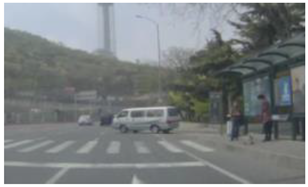 | A van parked on the roadside merged into the driving lane from the right without indicating |
| 3 | overt hazard |  | A pedestrian walked across the driving lane from the right side |
| 4 | overt hazard |  | A pedestrian walked into the driving lane from the right side of the road |
| 5 | overt hazard |  | A pedestrian walked into the driving lane from the left side of the road |
| 6 | overt hazard |  | In front of the camera car, a pedestrian in the driving lane walked toward the camera car |
| 7 | overt hazard |  | In front of the camera car, a black car going in the opposite direction pulled into the left lane |
| 8 | overt hazard |  | A motorcyclist was driving in the same lane in front of the camera car |
| 9 | overt hazard | 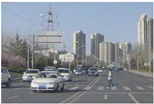 | A pedestrian standing in the center of the driving lane was in front of the camera car |
| 10 | covert hazard |  | A pedestrian behind the white car, which was going in the opposite direction, walked into the driving lane from the left side |
| 11 | covert hazard | 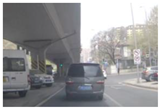 | Under the overpass, a bus in the reverse lane entering the main lane from the left side was obscured by parked cars |
| 12 | covert hazard | 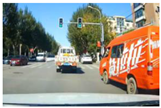 | A large red van in the adjacent lane occluded a pedestrian walking across the road from the same side |
| 13 | covert hazard |  | A vehicle parked on the right side of the road blocked a pedestrian going across the road |
| 14 | covert hazard | 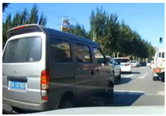 | A car going in the opposite direction blocked a pedestrian crossing the road from the left side |
| 15 | covert hazard | 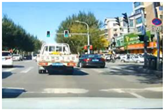 | A road maintenance crew was taking a road survey but the crew was obscured by the traffic ahead |
| 16 | covert hazard |  | The motorcyclist entering the lane in the same direction from the other side of the road was obscured by the vehicle in front of the camera car |
| 17 | covert hazard |  | A car stuck in a traffic jam in the adjacent lane was trying to merge into the driving lane and was blocked by cars behind it |
| 18 | covert hazard | 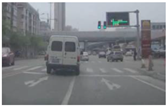 | At the intersection ahead, the car going in the opposite direction on the left turned right but the camera car was blocked by a van traveling in the same direction near the lane |
References
- Ministry of Transport of China. Development of Transportation Industry Statistics Report for 2021. 2022. Available online: https://xxgk.mot.gov.cn/2020/jigou/zhghs/202205/t20220524_3656659.html (accessed on 1 May 2023).
- La, Q.N.; Lee, A.H.; Meuleners, L.B.; Van Duong, D. Prevalence and factors associated with road traffic crash among taxi drivers in Hanoi, Vietnam. Accid. Anal. Prev. 2013, 50, 451–455. [Google Scholar] [CrossRef]
- Tseng, C.M. Operating styles, working time and daily driving distance in relation to a taxi driver’s speeding offenses in Taiwan. Accid. Anal. Prev. 2013, 52, 1–8. [Google Scholar] [CrossRef]
- Cai, A.W.T.; Manousakis, J.E.; Singh, B.; Kuo, J.; Jeppe, K.J.; Francis, P.E.; Shiferaw, B.; Beatty, C.J.; Rajaratnam, S.M.W.; Lenne, M.G.; et al. On-road driving impairment following sleep deprivation differs according to age. Sci. Rep. 2021, 11, 21561. [Google Scholar] [CrossRef]
- Mahajan, K.; Velaga, N.R.; Kumar, A.; Choudhary, P. Effects of driver sleepiness and fatigue on violations among truck drivers in India. Int. J. Inj. Control Saf. Promot. 2019, 26, 412–422. [Google Scholar] [CrossRef]
- Zeller, R.; Williamson, A.; Friswell, R. The effect of sleep-need and time-on-task on driver fatigue. Transp. Res. Part F Traffic Psychol. Behav. 2020, 74, 15–29. [Google Scholar] [CrossRef]
- Bartrim, K.; McCarthy, B.; McCartney, D.; Grant, G.; Desbrow, B.; Irwin, C. Three consecutive nights of sleep loss: Effects of morning caffeine consumption on subjective sleepiness/alertness, reaction time and simulated driving performance. Transp. Res. Part F Traffic Psychol. Behav. 2020, 70, 124–134. [Google Scholar] [CrossRef]
- Mahajan, K.; Velaga, N.R. Effects of Partial Sleep Deprivation on Braking Response of Drivers in Hazard Scenarios. Accid. Anal. Prev. 2020, 142, 105545. [Google Scholar] [CrossRef]
- Wijayanto, T.; Marcillia, S.R.; Lufityanto, G.; Wisnugraha, B.B.; Alma, T.G.; Abdianto, R.U. The effect of situation awareness on driving performance in young sleep-deprived drivers. IATSS Res. 2021, 45, 218–225. [Google Scholar] [CrossRef]
- Koopmans, I.; Doll, R.J.; van der Wall, H.; de Kam, M.; Groeneveld, G.J.; Cohen, A.; Zuiker, R. Fit for purpose of on-the-road driving and simulated driving: A randomised crossover study using the effect of sleep deprivation. PLoS ONE 2023, 18, e0278300. [Google Scholar] [CrossRef]
- Shiferaw, B.A.; Downey, L.A.; Westlake, J.; Stevens, B.; Rajaratnam, S.M.W.; Berlowitz, D.J.; Swann, P.; Howard, M.E. Stationary gaze entropy predicts lane departure events in sleep-deprived drivers. Sci. Rep. 2018, 8, 2220. [Google Scholar] [CrossRef]
- Caponecchia, C.; Williamson, A. Drowsiness and driving performance on commuter trips. J. Saf. Res. 2018, 66, 179–186. [Google Scholar] [CrossRef]
- Lee, S.; Kim, H.R.; Byun, J.; Jang, T. Sleepiness while driving and shiftwork patterns among Korean bus drivers. Ann. Occup. Environ. Med. 2017, 29, 48. [Google Scholar] [CrossRef]
- Mahajan, K.; Velaga, N.R. Effects of partial sleep deprivation: A comparative assessment of young non-professional and professional taxi drivers. Transp. Res. Part F Traffic Psychol. Behav. 2022, 85, 209–220. [Google Scholar] [CrossRef]
- He, J.; Li, Z.; Ma, Y.; Sun, L.; Ma, K.-H. Physiological and Behavioral Changes of Passive Fatigue on Drivers during On-Road Driving. Appl. Sci. 2020, 13, 1200. [Google Scholar] [CrossRef]
- Saxby, D.J.; Matthews, G.; Warm, J.S.; Hitchcock, E.M.; Neubauer, C. Active and passive fatigue in simulated driving: Discriminating styles of workload regulation and their safety impacts. J. Exp. Psychol. Appl. 2013, 19, 287–300. [Google Scholar] [CrossRef]
- Hu, X.; Lodewijks, G. Exploration of the effects of task-related fatigue on eye-motion features and its value in improving driver fatigue-related technology. Transp. Res. Part F Traffic Psychol. Behav. 2021, 80, 150–171. [Google Scholar] [CrossRef]
- Shekari Soleimanloo, S.; Wilkinson, V.E.; Cori, J.M.; Westlake, J.; Stevens, B.; Downey, L.A.; Shiferaw, B.A.; Rajaratnam, S.M.W.; Howard, M.E. Eye-Blink Parameters Detect On-Road Track-Driving Impairment Following Severe Sleep Deprivation. J. Clin. Sleep Med. JCSM Off. Publ. Am. Acad. Sleep Med. 2019, 15, 1271–1284. [Google Scholar] [CrossRef]
- Smith, S.S.; Horswill, M.S.; Chambers, B.; Wetton, M. Hazard perception in novice and experienced drivers: The effects of sleepiness. Accid. Anal. Prev. 2009, 41, 729–733. [Google Scholar] [CrossRef]
- Watling, C.N.; Home, M. Hazard perception performance and visual scanning behaviours: The effect of sleepiness. Transp. Res. Part F Traffic Psychol. Behav. 2022, 90, 243–251. [Google Scholar] [CrossRef]
- Wetton, M.A.; Horswill, M.S.; Hatherly, C.; Wood, J.M.; Pachana, N.A.; Anstey, K.J. The development and validation of two complementary measures of drivers’ hazard perception ability. Accid. Anal. Prev. 2010, 42, 1232–1239. [Google Scholar] [CrossRef] [PubMed]
- Crundall, D.; Chapman, P.; Trawley, S.; Collins, L.; van Loon, E.; Andrews, B.; Underwood, G. Some hazards are more attractive than others: Drivers of varying experience respond differently to different types of hazard. Accid. Anal. Prev. 2012, 45, 600–609. [Google Scholar] [CrossRef]
- Sun, L.; Hua, L. Effects of hazard types on drivers’ risk rating and hazard response in a video-based hazard perception task. PLoS ONE 2019, 14, e0214226. [Google Scholar] [CrossRef]
- Vlakveld, W.P. A comparative study of two desktop hazard perception tasks suitable for mass testing in which scores are not based on response latencies. Transp. Res. Part F Traffic Psychol. Behav. 2014, 22, 218–231. [Google Scholar] [CrossRef]
- Horswill, M.S.; Hill, A.; Taylor, J. Scores on a new hazard prediction test are associated with both driver experience and crash involvement. Transp. Res. Part F Traffic Psychol. Behav. 2020, 71, 98–109. [Google Scholar] [CrossRef]
- Horswill, M.S.; Hill, A.; Wetton, M. Can a video-based hazard perception test used for driver licensing predict crash involvement? Accid. Anal. Prev. 2015, 82, 213–219. [Google Scholar] [CrossRef] [PubMed]
- Sun, L.; Cheng, L.; Zhang, Q. The differences in hazard response time and driving styles of violation-involved and violation-free taxi drivers. Transp. Res. Part F Traffic Psychol. Behav. 2021, 82, 178–186. [Google Scholar] [CrossRef]
- Horswill, M.S. Hazard perception in driving. Curr. Dir. Psychol. Sci. 2016, 25, 425–430. [Google Scholar] [CrossRef]
- Sagberg, F.; Bjørnskau, T. Hazard perception and driving experience among novice drivers. Accid. Anal. Prev. 2006, 38, 407–414. [Google Scholar] [CrossRef] [PubMed]
- Crundall, D. Hazard prediction discriminates between novice and experienced drivers. Accid. Anal. Prev. 2016, 86, 47–58. [Google Scholar] [CrossRef] [PubMed]
- Rizalmi, S.R.; Wijayanto, T.; Rossano, R.; Trapsilawati, F.; Marcillia, S.R.; Lufityanto, G. The Effect of Passenger Interaction on Situation Awareness and Driving Performance in Sleep-Deprived Condition. In Proceedings of the 2019 5th International Conference on Science and Technology (ICST), Yogyakarta, Indonesia, 30–31 July 2020; IEEE: New York, NY, USA, 2020. [Google Scholar] [CrossRef]
- Lim, P.C.; Sheppard, E.; Crundall, D. Cross-cultural effects on drivers’ hazard perception. Transp. Res. Part F Traffic Psychol. Behav. 2013, 21, 194–206. [Google Scholar] [CrossRef]
- Parmet, Y.; Meir, A.; Borowsky, A. Survival analysis: A fresh approach for analyzing response times in driving-related hazard perception paradigms. Transp. Res. Part F Traffic Psychol. Behav. 2014, 25, 98–107. [Google Scholar] [CrossRef]
- Chen, S.; Sun, L.; Zhang, C. Adaptation and validity of the Sleep Quality Scale among Chinese drivers. PLoS ONE 2021, 16, e0259813. [Google Scholar] [CrossRef]
- Hoddes, E.; William, D.; Zarcone, V. The development and use of the Stanford sleepiness scale (SSS). Psychophysiology 1972, 10, 431–436. [Google Scholar] [CrossRef]
- Jackson, M.L.; Croft, R.J.; Kennedy, G.A.; Owens, K.; Howard, M.E. Cognitive components of simulated driving performance: Sleep loss effects and predictors. Accid. Anal. Prev. 2013, 50, 438–444. [Google Scholar] [CrossRef]
- Collet, J.; Ftouni, S.; Clough, M.; Cain, S.W.; Fielding, J.; Anderson, C. Differential Impact of Sleep Deprivation and Circadian Timing on Reflexive Versus Inhibitory Control of Attention. Sci. Rep. 2020, 10, 7270. [Google Scholar] [CrossRef]
- Higgins, J.S.; Michael, J.; Austin, R.; Åkerstedt, T.; Van Dongen, H.P.; Watson, N.; Czeisler, C.; Pack, A.I.; Rosekind, M.R. Asleep at the Wheel-The Road to Addressing Drowsy Driving. Sleep 2017, 40, zsx001. [Google Scholar] [CrossRef]
- Ahlström, C.; Anund, A.; Fors, C.; Åkerstedt, T. Effects of the road environment on the development of driver sleepiness in young male drivers. Accid. Anal. Prev. 2018, 112, 127–134. [Google Scholar] [CrossRef]
- Killgore, W.D.; Lipizzi, E.L.; Kamimori, G.H.; Balkin, T.J. Caffeine effects on risky decision making after 75 h of sleep deprivation. Aviat. Space Environ. Med. 2007, 78, 957–962. [Google Scholar] [CrossRef] [PubMed]
- Hunter, D.R. Risk Perception and Risk Tolerance in Aircraft Pilots: Decision Making; DOT/FAA/AM-02/17; US Department of Transportation: Washington, DC, USA, 2002.
- Nancy, J.W.; Thomas, J.B.; Gregory, B. Countermeasures for Mitigating Fatigue in Motor Vehicle Operators. Rev. Hum. Factors Ergon. 2015, 10, 115–137. [Google Scholar] [CrossRef]



| Variables | Control (n = 30) | Sleep Deprivation (n = 30) |
|---|---|---|
| Gender (Male/Female) | 25/5 | 22/8 |
| Age (years) | 34.73 ± 11.31 | 37.60 ± 10.87 |
| Driving experience (years) | 10.11 ± 10.22 | 11.25 ± 9.23 |
| Driving frequency (per week) | 3.57 ± 1.15 | 3.56 ± 1.72 |
| Traffic violations | 0.23 ± 0.43 | 0.67 ± 0.84 |
| Traffic accidents | 0.17 ± 0.38 | 0.37 ± 0.49 |
| Dependent Variables | Covert Hazard | Overt Hazard | ||
|---|---|---|---|---|
| Sleep-Deprived | Control | Sleep-Deprived | Control | |
| Response time(s) | 2.27 ± 0.19 | 1.88 ± 0.30 | 0.99 ± 0.17 | 1.23 ± 0.15 |
| Time to first fixation(s) | 1.53 ± 0.40 | 1.18 ± 0.26 | 0.95 ± 0.26 | 0.82 ± 0.20 |
| First fixation duration(s) | 1.26 ± 0.28 | 1.33 ± 0.26 | 1.28 ± 0.35 | 0.92 ± 0.23 |
| Total fixation duration(s) | 2.72 ± 0.18 | 2.50 ± 0.45 | 1.65 ± 0.18 | 1.08 ± 0.18 |
Disclaimer/Publisher’s Note: The statements, opinions and data contained in all publications are solely those of the individual author(s) and contributor(s) and not of MDPI and/or the editor(s). MDPI and/or the editor(s) disclaim responsibility for any injury to people or property resulting from any ideas, methods, instructions or products referred to in the content. |
© 2023 by the authors. Licensee MDPI, Basel, Switzerland. This article is an open access article distributed under the terms and conditions of the Creative Commons Attribution (CC BY) license (https://creativecommons.org/licenses/by/4.0/).
Share and Cite
Sun, L.; Zhang, M.; Qiu, Y.; Zhang, C. Effects of Sleep Deprivation and Hazard Types on the Visual Search Patterns and Hazard Response Times of Taxi Drivers. Behav. Sci. 2023, 13, 1005. https://doi.org/10.3390/bs13121005
Sun L, Zhang M, Qiu Y, Zhang C. Effects of Sleep Deprivation and Hazard Types on the Visual Search Patterns and Hazard Response Times of Taxi Drivers. Behavioral Sciences. 2023; 13(12):1005. https://doi.org/10.3390/bs13121005
Chicago/Turabian StyleSun, Long, Meiqi Zhang, Yuanbo Qiu, and Changlu Zhang. 2023. "Effects of Sleep Deprivation and Hazard Types on the Visual Search Patterns and Hazard Response Times of Taxi Drivers" Behavioral Sciences 13, no. 12: 1005. https://doi.org/10.3390/bs13121005





